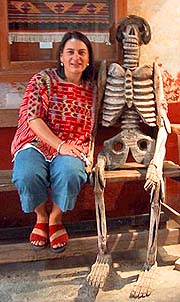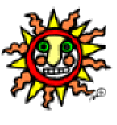Dia de Muertos:
The Dead Come to Life in Mexican Folk Art
By Mary Jane Gagnier Mendoza
Her Email
Her Bio
 For
foreigners, the traditions and celebrations in Mexican homes and
cemeteries during the Day of the Dead seem strange, if not
incomprehensible. There is mourning and rejoicing; sadness and silliness
- woven together into one emotional fabric. For
foreigners, the traditions and celebrations in Mexican homes and
cemeteries during the Day of the Dead seem strange, if not
incomprehensible. There is mourning and rejoicing; sadness and silliness
- woven together into one emotional fabric.
To me, it's like welcoming the return of a dear friend or relative,
who moved far away and visits just once a year. Mexicans try very hard
to be with their families for this fiesta, as the living and the
dead gather for the most complete of family reunions.
The Day of the Dead activities actually span several days, beginning
late at night Oct. 31, when the spirits of dead children (angelitos)
start arriving, followed by adult spirits sometime during Nov. 1. They
leave, after joining in a family meal, on Nov. 2. Although exact times
for the spirits' entrances vary from pueblo to pueblo, the angelitos
always arrive ahead of the adults.
I grew up in a French-Canadian Catholic family. From an early age, I
believed that when you died, you put on a white satin smock with lace
around the cuffs and joined the anonymous army of souls (in heaven if
you were lucky).
 Mexicans have a distinctly different view of themselves in the
afterlife. First, you keep your identity, since to return to this world
for the Day of the Dead, you must remain who you were. This explains the
profusion of skeletons of all sizes, doing ordinary day-to-day things.
If uncle José was a barber, he continues as a barber after death.
Placing a skeleton figure of a barber on your altar reaffirms to uncle
José that he has not been forgotten on his spiritual return.
Mexicans have a distinctly different view of themselves in the
afterlife. First, you keep your identity, since to return to this world
for the Day of the Dead, you must remain who you were. This explains the
profusion of skeletons of all sizes, doing ordinary day-to-day things.
If uncle José was a barber, he continues as a barber after death.
Placing a skeleton figure of a barber on your altar reaffirms to uncle
José that he has not been forgotten on his spiritual return.
Most Oaxacan homes have a highly adorned Day of the Dead altar. Sugar
skulls with the names of dead loved ones inscribed in their icing
indicate to the returning spirits that they have indeed returned to the
right spot, where the living await their arrival. The altar is a sort of
landing pad and its objects serve as signals to guide the spirits home.
Throughout the year, but especially during the Day of the Dead
season, calacas, or skeletons, are displayed in shops throughout
the city. In the Abastos market, for a few pesos each, you'll find
cardboard, wire and cotton-ball figures depicting nearly every walk of
life. The more upscale folk art stores display elaborate ceramic and
paper mache calacas, individually signed by renowned Mexican folk
artists.
This information comes from:
http://www.mexconnect.com/mex_/travel/mjmendoza/mjmdiadelasmuertos.html
|
 ¡En español!
¡En español!
 ¡En español!
¡En español!